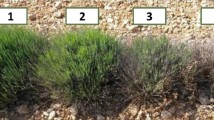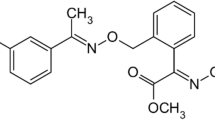Abstract
While most risk assessments contrast a transgenic resistant to its isogenic line, an additional comparison between the transgenic line and a classically bred cultivar with the same resistance gene would be highly desirable. Our approach was to compare headspace volatiles of transgenic scab resistant apple plants with two representative cultivars (the isogenic ‘Gala’ and the scab resistance gene-containing ‘Florina’). As modifications in volatile profiles have been shown to alter plant relationships with non-target insects, we analysed headspace volatiles from apple plants subjected to different infection types by gas chromatography-mass spectrometry. Marked differences were found between healthy and leafminer (Phyllonorycter blancardella) infested genotypes, where emissions between the transgenic scab resistant line and the two cultivars differed quantitatively in four terpenes and an aromatic compound. However, these modified odour emissions were in the range of variability of the emissions recorded for the two standard cultivars that proved to be crucial references.

Similar content being viewed by others
References
Aharoni A, Jongsma MA, Bouwmeester HJ (2005) Volatile science? Metabolic engineering of terpenoids in plants. Trends Plant Sci 10:594–602
Álvarez-Alfageme F, Ferry N, Castañera P et al (2008) Prey mediated effects of Bt maize on fitness and digestive physiology of the red spider mite predator Stethorus punctillum Weise (Coleoptera: Coccinellidae). Transgenic Res 17:943–954
Andow DA, Zwahlen C (2006) Assessing environmental risks of transgenic plants. Ecol Lett 9:196–214
Arimura G-I, Kost C, Boland W (2005) Herbivore-induced, indirect plant defences. Biochim Biophys Acta 1734:91–111
Baldwin IT, Halitschke R, Paschold A et al (2006) Volatile signaling in plant-plant interactions: “talking trees” in the genomic era. Science 311:812–815
Belfanti E, Silfverberg-Dilworth E, Tartarini S et al (2004) The HcrVf2 gene from a wild apple confers scab resistance to a transgenic cultivated variety. Proc Natl Acad Sci USA 101:886–890
Bennett RN, Wallsgrove RM (1994) Secondary metabolites in plant defence mechanisms. New Phytol 127:617–633
Boevé J-L, Lengwiler U, Tollsten L et al (1996) Volatiles emitted by apple fruitlets infested by larvae of the European apple sawfly. Phytochemistry 42:373–381
Bradley SJ, Suckling DM (1995) Factors influencing codling moth larval response to α-farnesene. Entomol Exp Appl 75:221–227
Casado D, Gemeno C, Avilla J et al (2006) Day-night and phenological variation of apple tree volatiles and electroantennogram responses in Cydia pomonella (Lepidoptera: Tortricidae). Environ Entomol 35:258–267
Casado D, Gemeno C, Avilla J et al (2008) Diurnal variation of walnut tree volatiles and electrophysiological responses in Cydia pomonella (Lepidoptera: Tortricidae). Pest Manag Sci 64:736–747
Chen M, Zhao J-Z, Shelton AM et al (2008) Impact of single-gene and dual-gene Bt broccoli on the herbivore Pieris rapae (Lepidoptera: Pieridae) and its pupal endoparasitoid Pteromalus puparum (Hymenoptera: Pteromalidae). Transgenic Res 17:545–555
Collinge DB, Lund OS, Thordal-Christensen H (2008) What are the prospects for genetically engineered, disease resistant plants? Eur J Plant Pathol 121:217–231
Connor EC, Rott AS, Zeder M et al (2008) 13C-labelling patterns of green leaf volatiles indicating different dynamics of precursors in Brassica leaves. Phytochemistry 69:1304–1312
Cuéllar J (1991) Statistical process control for nonnormally distributed variables through the use of transformations. ASMC 91 Proceedings, pp 143–148
Dandekar AM, Teo G, Defilippi BG et al (2004) Effect of down-regulation of ethylene biosynthesis on fruit flavor complex in apple fruit. Transgenic Res 13:373–384
Dean JM, De Moraes CM (2006) Effects of genetic modification on herbivore-induced volatiles from maize. J Chem Ecol 32:713–724
Dorn S, Schumacher P, Abivardi C et al (1999) Global and regional pest insects and their antagonists in orchards: spatial dynamics. Agric Ecosyst Environ 73:111–118
Dudareva N, Andersson S, Orlova I et al (2005) The nonmevalonate pathway supports both monoterpene and sesquiterpene formation in snapdragon flowers. Proc Natl Acad Sci USA 102:933–938
Dutton A, Mattiacci L, Dorn S (2000) Learning used as a strategy for host stage location in an endophytic host-parasitoid system. Entomol Exp Appl 94:123–132
Ebel RC, Mattheis JP, Buchanan DA (1995) Drought stress of apple trees alters leaf emissions of volatile compounds. Physiol Plant 93:709–712
Fidantsef AL, Stout MJ, Thaler JS et al (1999) Signal interactions in pathogen and insect attack: expression of lipoxygenase, proteinase inhibitor II, and pathogenesis-related protein P4 in the tomato, Lycopersicon esculentum. Physiol Mol Plant Pathol 54:97–114
Flor HH (1971) Current status of the gene-for-gene concept. Annu Rev Phytopathol 9:275–296
Gessler C, Stumm D (1984) Infection and stroma formation by Venturia inaequalis on apple leaves with different degrees of susceptibility to scab. J Phytopathol 110:119–126
Gessler C, Patocchi A, Sansavini S et al (2006) Venturia inaequalis resistance in apple. Crit Rev Plant Sci 25:473–503
Gouinguené S, Degen T, Turlings TCJ (2001) Variability in herbivore-induced odour emissions among maize cultivars and their wild ancestors (teosinte). Chemoecology 11:9–16
Hern A, Dorn S (1999) Sexual dimorphismus in the olfactory orientation of adult Cydia pomonella in response to α-farnesene. Entomol Exp Appl 92:63–72
Hern A, Dorn S (2001) Induced emissions of apple fruit volatiles by the codling moth: changing patterns with different time periods after infestation and different larval instars. Phytochemistry 57:409–416
Hern A, Dorn S (2002) Induction of volatile emissions from ripening apple fruits infested with Cydia pomonella and the attraction of adult females. Entomol Exp Appl 102:145–151
Hern A, Dorn S (2004) A female-specific attractant for the codling moth, Cydia pomonella, from apple fruit volatiles. Naturwissenschaften 91:77–80
Kindt M, Orsini MC, Costantini B (2007) Improved high-performance liquid chromatography-diode array detection method for the determination of phenolic compounds in leaves and peels from different apple varieties. J Chromatogr Sci 45:507–514
Kishimoto K, Matsui K, Ozawa R et al (2008) Direct fungicidal activities of C6-aldehydes are important constituents for defence responses in Arabidopsis against Botrytis cinerea. Phytochemistry 69:2127–2132
Landolt PJ, Brumley JA, Smithhisler CL et al (2000) Apple fruit infested with codling moth are more attractive to neonate codling moth larvae and possess increased amounts of (E,E)-α-farnesene. J Chem Ecol 26:1685–1699
Lichtenthaler HK, Rohmer M, Schwender J (1997) Two independent biochemical pathways for isopentenyl diphosphate and isoprenoid biosynthesis in higher plants. Physiol Plant 101:643–652
MacHardy WE, Gadoury DM, Gessler C (2001) Parasitic and biological fitness of Venturia inaequalis: relationship to disease management strategies. Plant Dis 85:1036–1050
Marvier M, McCreedy C, Regetz J et al (2007) A meta-analysis of effects of Bt cotton and maize on nontarget invertebrates. Science 316:1475–1477
Paré PW, Tumlinson JH (1999) Plant volatiles as a defence against insect herbivores. Plant Physiol 121:325–331
Piñero JC, Dorn S (2007) Synergism between aromatic compounds and green leaf volatiles derived from the host plant underlies female attraction in the oriental fruit moth. Entomol Exp Appl 125:185–194
Piñero JC, Prokopy RJ (2003) Field evaluation of plant odor and pheromonal combinations for attracting plum curculios. J Chem Ecol 29:2735–2748
Piñero JC, Galizia CG, Dorn S (2008) Synergistic behavioral responses of female oriental fruit moths (Lepidoptera: Tortricidae) to synthetic host plant-derived mixtures are mirrored by odor-evoked calcium activity in their antennal lobes. J Insect Physiol 54:333–343
Poppy GM (1997) Tritrophic interactions: improving ecological understanding and biological control? Endeavour 21:61–65
Poppy GM, Sutherland JP (2004) Can biological control benefit from genetically-modified crops? Tritrophic interactions on insect-resistant transgenic plants. Physiol Entomol 29:257–268
Qubbaj T, Reineke A, Zebitz CPW (2005) Molecular interactions between rosy apple aphids, Dysaphis plantaginea, and resistant and susceptible cultivars of its primary host Malus domestica. Entomol Exp Appl 115:145–152
Reissig WH, Weires RW, Forshey CG (1982) Effects of Gracillariid leafminers on apple tree growth and production. Environ Entomol 11:958–963
Romeis J, Meissle M, Bigler F (2006) Transgenic crops expressing Bacillus thuringiensis toxins and biological control. Nat Biotechnol 24:63–71
Romeis J, Bartsch D, Bigler F et al (2008) Assessment of risk of insect-resistant transgenic crops to nontarget arthropods. Nat Biotechnol 26:203–208
Rostás M, Ton J, Mauch-Mani B et al (2006) Fungal infection reduces herbivore-induced plant volatiles of maize but does not affect naïve parasitoids. J Chem Ecol 32:1897–1909
Rott AS, Häckermann J, Brand N et al (2005) Parasitoid exploitation of the seasonal variation in host plant volatile emission for herbivore location. Entomol Exp Appl 115:199–205
Salch YP, Grove MJ, Takamura H et al (1995) Characterization of a C-5, 13-cleaving enzyme of 13(S)-hydroperoxide of linolenic acid by soybean seed. Plant Physiol 108:1211–1218
Scascighini N, Mattiacci L, D’Alessandro M et al (2005) New insights in analysing parasitoid attracting synomones: early volatile emission and use of stir bar sorptive extraction. Chemoecology 15:97–104
Schuler TH, Potting RPJ, Denholm I et al (2003) Tritrophic choice experiments with Bt plants, the diamondback moth (Plutella xylostella) and the parasitoid Cotesia plutella. Transgenic Res 12:351–361
Steiger S, Peschke K, Francke W et al (2007) The smell of parents: breeding status influences cuticular hydrocarbon pattern in the burying beetle Nicrophorus vespilloides. Proc R Soc B 274:2211–2220
Steiner S, Mumm R, Ruther J (2007) Courtship pheromones in parasitic wasps: comparison of bioactive and inactive hydrocarbon profiles by multivariate statistical methods. J Chem Ecol 33:825–838
Stewart-Jones A, Poppy GM (2006) Comparison of glass vessels and plastic bags for enclosing living plant parts for headspace analysis. J Chem Ecol 32:845–864
Stoeckli S, Mody K, Gessler C et al (2008) QTL analysis for aphid resistance and growth traits in apple. Tree Genet Genomes 4:833–847
Trabue SL, Anhalt JC, Zahn JA (2006) Bias of tedlar bags in the measurement of agricultural odorants. J Environ Qual 35:1668–1677
Turlings TCJ, Jeanbourquin PM, Held M et al (2005) Evaluating the induced-odour emission of a Bt maize and its attractiveness to parasitic wasps. Transgenic Res 14:807–816
Vallat A, Dorn S (2005) Changes in volatile emissions from apple trees and associated response of adult female codling moths over fruit-growing season. J Agric Food Chem 53:4083–4090
Vallat A, Gu H, Dorn S (2005) How rainfall, relative humidity and temperature influence volatile emissions from apple trees in situ. Phytochemistry 66:1540–1550
Vinatzer BA, Patocchi A, Gianfranceschi L et al (2001) Apple contains receptor-like genes homologous to the Cladosporium fulvum resistance gene family to tomato with a cluster of genes cosegregating with Vf apple scab resistance. Mol Plant Microbe Interact 14:508–515
Wearing CH, Hutchins RFN (1973) α-Farnesene, a naturally occuring oviposition stimulant for the codling moth, Laspeyresia pomonella. J Insect Physiol 19:1251–1256
Williams EB, Kuc J (1969) Resistance in Malus to Venturia inaequalis. Annu Rev Phytopathol 7:223–246
Acknowledgments
This project was supported by a grant of the Swiss Federal Office of the Environment (BAFU) to S. Dorn, A.S. Rott and C. Gessler. We thank H.-R. Roth for statistical, C. Fornallaz and E. Connor for technical advice, and A. Najar-Rodriguez and D. Mazzi and two anonymous reviewers for useful comments on the manuscript.
Author information
Authors and Affiliations
Corresponding author
Rights and permissions
About this article
Cite this article
Vogler, U., Rott, A.S., Gessler, C. et al. Comparison between volatile emissions from transgenic apples and from two representative classically bred apple cultivars. Transgenic Res 19, 77–89 (2010). https://doi.org/10.1007/s11248-009-9294-8
Received:
Accepted:
Published:
Issue Date:
DOI: https://doi.org/10.1007/s11248-009-9294-8




